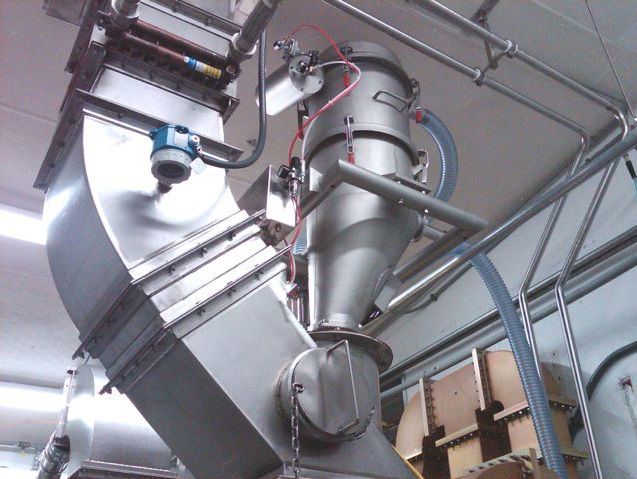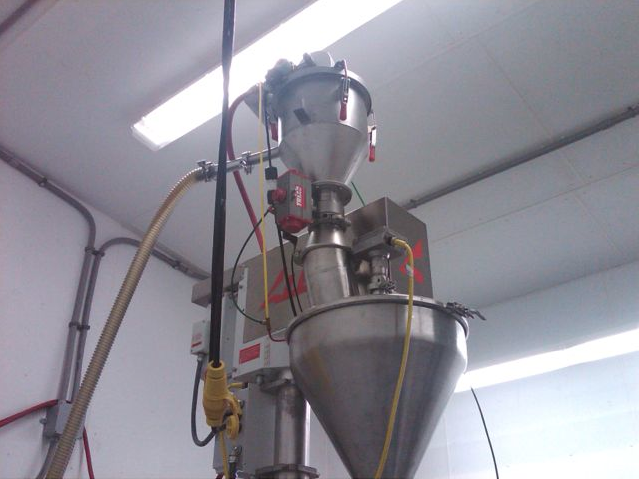Nutriom sets the bar high when it comes to producing its premium quality natural powdered egg products Ova Easy® and Egg Crystals®, that are sold at outdoor retailers such as REI, and online merchants such as Amazon.com; so, when the screw conveyor in their FSIS USDA facility required regular unexpected attention, Leonardo Etcheto, Plant Manager at the Lacey, WA facility knew it was time to look for a better solution.
Seeking a Unique Conveying System
Nutriom developed a unique process to produce its egg products which preserves the flavor and functionality of the eggs, and needed a materials handling system that would work within that specialized process to improve efficiency without damaging the crystals.
“The screw conveyor was a difficult system to handle,” says Etcheto. “There were a lot of moving parts and that meant there were more things that could go wrong. It was a difficult system to clean and to perform maintenance.”
Improved efficiency and gentle transfer weren’t the only provisions Etcheto required. “Our technology is very different and we’re a little pickier than your average company. We needed a conveyor manufacturer that was able to modify its equipment to meet our needs,” he says.
When attending a trade show for food manufacturers, Etcheto visited the booths of conveyor manufacturers. “We wanted something that would not touch the product, allow us to be full stainless steel, and one of the biggest things is we wanted to get away from having to use oil,”.
The food-grade screw conveyor at the Lacey plant had a plastic housing outside the screw conveyor. Plastic components from equipment in the food industry hold the potential to deposit debris or shavings into product undetected, and Nutriom preferred to eliminate that potential. The screw conveyor also housed a gearbox on top of the unit that required expensive H1 lubricants that on occasion, despite regular maintenance, would leak and create a mess.

Pneumatic Conveying Protects High Quality Products
After contacting a couple of East coast pneumatic conveyor manufacturers, Etcheto decided that one of the manufacturers could accommodate all his requirements. “We have a lot of height restrictions because our building is older and has many areas with low ceilings and VAC-U-MAX was able to come up with a system that could fit in the space that we needed to fit into.”
Celebrating its 60th year designing and manufacturing innovative pneumatic conveyor systems and support equipment for the conveying, weighing, and batching of dry materials, Belleville, NJ-based VAC-U-MAX is a pioneer with many industry firsts including air-powered venturi power units, direct-loading of vacuum-tolerant process equipment, and vertical-wall Tube Hopper material receivers.
Etcheto began with one pneumatic conveying system from the company and, based on its successful performance, “we just kept adding,” he says. The facility utilizes two pneumatic conveyors that connect to packaging systems, two that connect to the low temperature driers and two that connect to a mixer -one system breaks up the powder and puts it into the mixer and the other pulls it out.

Nutriom uses two VAC-U-MAX pneumatic conveyors with a mixer — one system breaks the powder up and puts
it into the mixer and the other pulls it out of the mixer.
“One of the reasons we use pneumatics is because we produce a very high quality, high priced product and we want to make sure that we maintain the high quality. The systems do a good job pulling the product without damaging it.”
Previously, the screw conveyor would grind the egg product down as it transferred the material which made the crystals more difficult to handle. The screw conveyor also needed a fair amount of egg to be in the system for it to work properly which would sometimes bog down the process.
“The enclosed system allows for more ideal handling,” says Etcheto. “It’s standard GMP to make sure that nobody is handling our product, and the system easily allows us to do that. It is always traveling pneumatically through stainless lines,” he says. “It is definitely cleaner than the screw conveyor we used before.”
Experience with Food Manufacturers
VAC-U-MAX vacuum conveying systems are fully enclosed, protecting materials from air, dirt and waste. Because product does not escape from a vacuum conveying system, particulates that can endanger or jam expensive equipment are prevented from entering the environment.
Having worked with a host of major food manufacturers including General Mills, Kraft Foods, and Kellogg Company, as well as many smaller specialty food manufacturers, the conveyor manufacturer is no stranger to the strict regulations that exist in the food industry. This expertise lent itself to understanding the needs of Nutriom and the creation of a custom system that was more efficient, reduced labor, improved ergonomics, and made compliance with stringent FSIS USDA regulations simpler.
The vacuum conveying systems are complete stainless steel construction and all product contact areas are 316L with a polished surface for ease of cleaning and product flow. Nutriom utilizes two separate types of vacuum generation to accommodate its unique process. For areas with low ceiling clearance VAC-U-MAX modified its filter lids to fit the tight spaces and these units use compressed air to generate vacuum. In areas where ceiling height is not an issue, more efficient vacuum pumps are utilized.
To further accommodate Nutriom’s stringent standards, the conveyor manufacturer replaced the iron rings that secured the filter with stainless steel rings. Etcheto says, “they’re cleaner, fit better within our inspection system and last a lot longer.”

VAC-U-MAX custom pneumatic conveying system above filling machine at Nutriom plant.
In addition to streamlining materials transfer and enhancing sanitation practices, the system has also improved ergonomics in the plant. “One of our systems only moves the powder about 10 feet, but it moves 10 feet up. Before implementing the pneumatic conveyors, the material had to be transferred manually and now that’s not an issue,” says Etcheto.
In the beginning, there was a learning curve, he says. “You’ve got to set them up right. You can’t have tight turns, you need the right amount of air flow, but once you figure them out, they really aren’t that complicated.”
Etcheto appreciates that the VAC-U-MAX system uses standard dairy wiring with all 30A clamps, and says that operators do most of the maintenance themselves and have no issues keeping the systems running. The systems he says are “easy to put together and take apart because they use standard parts the operators are used to, and they don’t need tools.”
“Over time, it’s really been surprising how reliable the VAC-U-MAX systems are,” says Etcheto. “With the screw conveyor we had to do something to it at least once a month. By replacing it with a pneumatic conveying system, we have saved over $150,000 annually. That is really good technology.”
Founded in 1954, VAC-U-MAX has been at the forefront of leading edge conveying systems and components across a wide range of industries including food, pharmaceutical, chemical and industrial markets. To learn more about how VAC-U-MAX pneumatic conveying systems can improve efficiency, ergonomics, preserve product integrity, or reduce costs, write to them at 69 William Street, Belleville, NJ 07109; call 1-800-822-8629; e-mail; or visit www.vac-u-max.com.
For more information contact Doan Pendleton, Vice President Sales, VAC-U-MAX.
To read more Vacuum Technology articles, visit www.blowervacuumbestpractices.com/technology/conveying.



